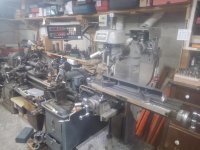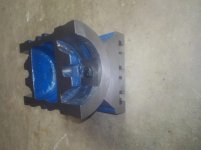I started with a rough casting I bought from Denis Foster and will document my progress. I am a hobbyist machinist and beginner at scrapeing so any comments or suggestions will be appreciated. A search for "18" Iron Straight Edge Featherweight Raw" will show what I started with, I contacted Denis Foster directly, email][email protected][/email] He has documented how he machines the raw castings, [url] clearly has a well developed process for machining but I decided to machine it myself as I currently have more time than money. I was very impressed with the shipping, it arrived inside a fitted wood box. I first tried hand scrapeing the raw casting, this resulted in just some dust (as expected) so I gave up on that. Next I went at it with the 7" angle grinder, it took a couple of hours to get the bottom reasonably flat.

I did some scrapeing on the ground surface and found it took a bit of work to get thru the fairly deep grinding scratches. But now I have a surface that can be clamped to the milling table. In hindsight I could have just ground 2 flat areas under the clamps and ground everything else a little lower. My milling machine only has 15" of travel so milling will need to be done in steps. First the center area of the top and sides, machined very well with standard end mill.

Next the part was flipped and held in the vise to machine the bottom surface with a fly cutter. The part needed to be shifted in the vise to machine the entire bottom. Positive rake seemed to work better than negative that is often recommended for cast iron.

more to come

I did some scrapeing on the ground surface and found it took a bit of work to get thru the fairly deep grinding scratches. But now I have a surface that can be clamped to the milling table. In hindsight I could have just ground 2 flat areas under the clamps and ground everything else a little lower. My milling machine only has 15" of travel so milling will need to be done in steps. First the center area of the top and sides, machined very well with standard end mill.

Next the part was flipped and held in the vise to machine the bottom surface with a fly cutter. The part needed to be shifted in the vise to machine the entire bottom. Positive rake seemed to work better than negative that is often recommended for cast iron.

more to come














